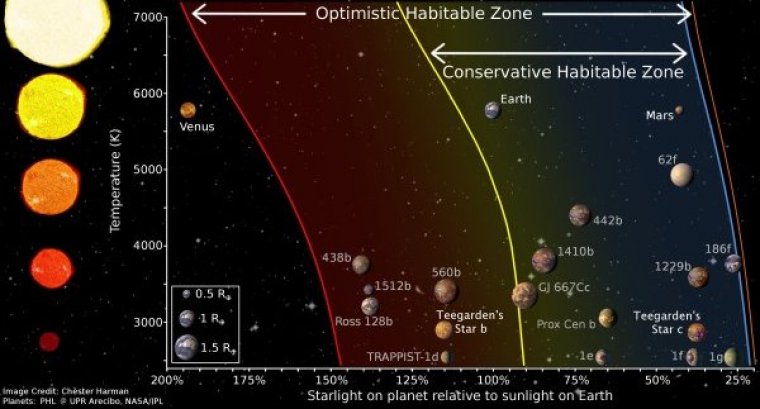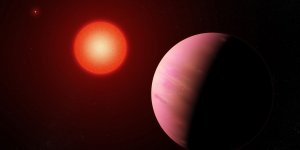| News / Space News |
Researchers find two new planets with masses similar to Earth’s near a small neighbouring star
Researchers discovered two Earth-like planets near Teegarden’s Star.

Illustration of the habitable zone for different stars. Photo: Chester Harman/PHL @ UPR Arecibo, NASA/JPL
The masses of these planets are similar to the Earth’s, and their temperatures could be low enough for water in liquid form to be present on the surface. The observations were carried out using the CARMENES instrument (Calar Alto High-Resolution Search for M dwarfs with Exoearths with Near-infrared and optical Échelle Spectrographs) at the Calar Alto Observatory in Almería, as well as at smaller, complementary facilities, such as the Sierra Nevada Observatory in Granada and the Joan Oró Telescope at the Observatori Astronomic del Montsec, which pertains to the Institut d’Estudis Espacials de Catalunya (IEEC).
At just 12.5 light years from the Earth, Teegarden’s Star is the 24th-nearest known star system to our Solar System, and one of the smallest “red dwarf” stars discovered to date. Despite its proximity, because of its dimness Teegarden’s Star was not identified until 2003.
The method used for detection of planets is known as the Doppler technique. When a planet orbits a star, it triggers a small reflex movement back and forth. This shift creates a very subtle Doppler effect in the light dispersed by stars, which, by using CARMENES, can be measured with an accuracy of 1 metre per second—equivalent to walking speed, or, 3.6km per hour.
Small planets produce small signals, but these are easier to detect in the case of low-mass red dwarves (such Teegarden’s Star), because the reflex movement is greater and repeats more often than in the case of stars such as the Sun.
CARMENES is the first high-precision spectrometer in operation that is designed specifically to find planets using this ‘red dwarf advantage‘.
From very early on, the Doppler measurements for Teegarden’s Star showed the presence of at least two signals, now identified as the two new exoplanets called Teegarden b and c. In order to ensure the detection was reliable, with a new instrument, over 200 measurements needed to be made.
Based on these measurements of movement, the researchers could deduce that the mass of Teegarden b is similar to the Earth’s and that it orbits the star every 4.9 days at 2.5% of the distance between the Earth and the Sun. The planet Teegarden c is similar to Earth in terms of mass, completes its orbit in 11.4 days, and is located relative to its star at 4.5% of the Earth–Sun distance.
Since Teegarden’s Star radiates much less energy than our Sun, temperatures on these planets are relatively cool and could, in principle, enable liquid water to sit on their surfaces (particularly the outermost of the two, Teegarden c). This type of planet will continue to be the focus of future searches for life beyond our Solar System.
This discovery is a major success for the CARMENES project, which was designed specifically to look for planets around lighter stars. These two planets may be part of a larger system. Extremely low-mass stars appear to have densely-populated planetary systems. (University of Granada)
YOU MAY ALSO LIKE





